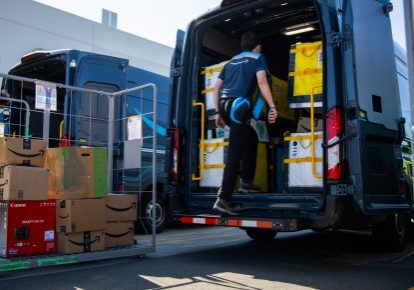
Nailing eCommerce logistics is one of the toughest problems you’ll face as an online retailer. As more and more fulfillment and logistics operations get automated through software, robotics, and other technology, the pressure is on for e-commerce businesses to perform at peak levels.
A lot of the pressure is created by rising customer expectations about free and fast shipping, which leaves the onus on the business to find the right balance. People want their orders to arrive within two days (the “Amazon Prime” effect) but they don’t want to pay for it.
Statista reports that 65% of US consumers expect to receive their online orders within two to three days. But also, online shoppers are much more likely to make a purchase if shipping is free, citing that value as their #1 consideration.
Therefore, fast and efficient eCommerce logistics represent a competitive advantage. Conversely, if a logistics process doesn’t meet customer expectations it becomes a huge risk to the business.
Striking this balance correctly can be the difference between losing a customer if you charge too much and losing any profit if you charge too little. Just for you, we’ve gathered some pro tips on wrangling your eCommerce logistics to minimize risks and maximize profits.
Packing & Shipping
1. Balance value-add logistics with profit
Having your products perfectly packaged can delight your customers, but these value-added services can cause more trouble than they’re worth. Bespoke boxes, fancy wrappings and other customizations take extra time and cost a lot more than throwing it in a cardboard box. There are middle-ground packing options that could work better. When selecting a fulfillment partner, shop around and ask hard questions about cost and delivery times until you find just enough value-add for a unit price you can afford.
2. Evaluate your package sizes to determine which shipping strategy is most cost-effective.
If your products are relatively uniform in size and weight, then you should be looking at a per-item, zone-based approach. With this model, the shipping price varies by your customer’s location rather than by product size or weight.
This strategy also makes possible easy-to-understand promotions like $10 shipping per order, $5 shipping per item, or free shipping on orders over $50.
For retailers with varying sizes and weights among your product set, you will still need to get rates directly from a carrier like UPS, DHL, FedEx, etc.
3. Automate carrier selection.
Let’s face it, shipping is a major cost for online retailers. Selecting the right service level and carrier to minimize those costs while keeping customers satisfied is complex and challenging. For larger e-commerce businesses with a high volume of orders, manual rate comparison is itself too time-consuming. If your volume justifies it, you can automate carrier selection with shipping technology. It rate-shops multiple carriers and evaluates service levels and determines the optimal time-in-transit versus cost scenario. It then will select the most efficient, cost-effective carrier for each shipment.
4. Develop a local delivery solution if most of your business is regional.
You’re not stuck with only the big-name carriers. Many local delivery services offer same-day delivery, next-day delivery, or timely and cost-effective delivery for even the largest items. In major cities, local delivery and courier companies can be found that will deliver more quickly to your customers than the big carriers, at very competitive rates.
Transparency with customers
5. Show delivery times and provide tracking information.
This is another area where online shoppers’ expectations have risen to levels that challenge an e-commerce businesse. People are becoming more and more impatient. And they increasingly expect readily available information about when their online orders will arrive.
Having that estimated number of delivery days, or an expected delivery date, is now pretty much essential. Ideally, that information will be available right on the order page, before they make a purchase. Once you have that, you can also offer upgrade options for faster delivery. But minimally, you should send shipping and delivery information in a confirmation email, and provide them with a tracking number. This way they don’t have to pester you once you’ve handed off their package to the carrier.
6. Offer free in-store pickup.
While this option was already offered by a few retailers who also have brick-and-mortar stores, the BOPIS (Buy Online, Pick Up In Store) model really took off during the first year of the Pandemic, when many businesses had to shut down altogether. But even once stores opened back up, it continues to be a wildly popular way to shop. Whether offering curbside delivery or pickup at a Customer Service counter, this hybrid shopping model is definitely here to stay.
Inventory controls
7. When selling through multiple channels, use a product feed syndication service.
Connecting to a diverse range of e-commerce marketplaces is one of the best ways to scale your e-commerce business to new heights. But a multi-marketplace, multi-tactic strategy can quickly become a hot mess if you’re not careful. The biggest danger is over-selling. No matter how good your logistics operation, you can’t deliver what’s not in the warehouse. And the best way to avoid that is to use a product feed syndication service such as Shoppingfeed. With a feed service, you can sell across many channels including marketplaces, search engine ads, or price comparison sites, while monitoring inventory levels in real-time to assure that every order on every channel can be fulfilled, or show when an item is out of stock.
The best advice for wrangling eCommerce logistics? Do your research, and stay on your toes.




